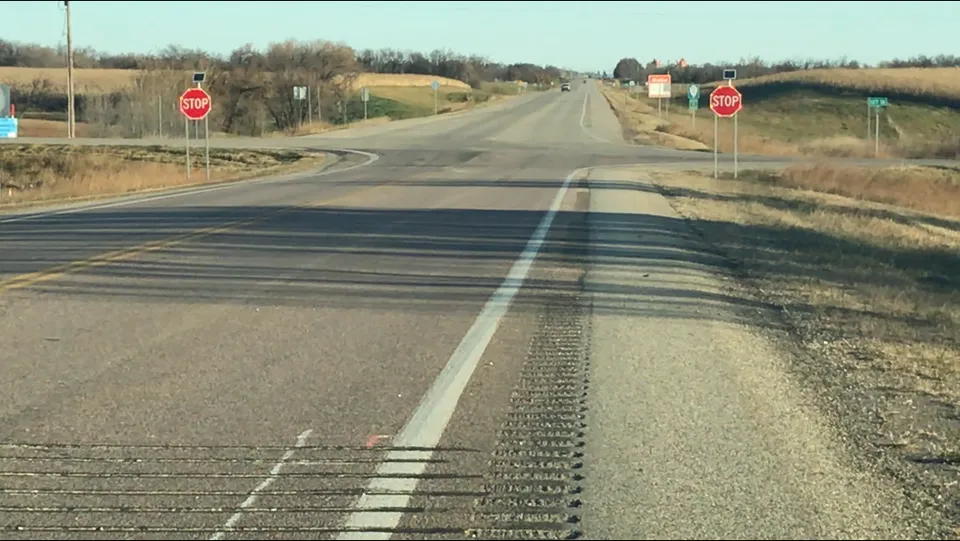High Risk Intersections and Roadway Departure Risks addressed through systemic safety improvements
The Sisseton Wahpeton Oyate (SWO) Tribe of the Lake Traverse Reservation is improving roadway safety through systemic application of two proven safety countermeasures: edge-line rumble stripes and multiple low-cost countermeasures at stop-controlled intersections.
Through a grant from the Federal Highway Administration’s (FHWA) Tribal Transportation Program Safety Fund (TTPSF), provided through the FHWA Office of Tribal Transportation, the SWO Tribe installed 30.6 miles of narrow-width (8-inch) rumble stripes on roadways with little or no shoulder, and installed multiple low-cost countermeasures at 13 rural, stop-controlled intersections. Similar to the Highway Safety Improvement Program (HSIP), projects funded by the TTPSF must be data-driven and identified in a transportation safety plan.
The SWO Tribe developed a transportation safety plan using the five-step process developed by the University of Wyoming, combining crash data and qualitative field observations to identify not only high-crash locations but also systemic safety risks. This study evaluated crash data from 2004–2013 and found 1,065 recorded crashes for the SWO Tribe. Thirty percent of these crashes resulted in injury and 3 percent were fatal, compared to all crashes in South Dakota in which 24 percent involved an injury and only 1 percent resulted in fatalities. Among the crash data for the Lake Traverse Reservation, 46 percent of reported crashes were off-roadway crashes, which aligns with the crash experience in the rest of South Dakota. There was also a high instance of intersection-related crashes (20 percent of all crashes on the Lake Traverse Reservation).
The resulting SWO Roadway Safety Improvement Plan identifies safety improvements both to address locations and risks. High-crash concentrations are identified at several intersections on the reservation. These locations received safety enhancements, including installation of oversized stop signs, supplemental installation of a left-side stop sign, LED-flashing borders around stop signs, advanced transverse rumble strips, and stop-ahead warning signs.
The crash data also identified roadway departure as a concern, but such crashes were scattered across the roadway network rather than at a specific location. As a result, the plan recommends systemic improvement on corridors with the highest risk for fatal or serious injury roadway departure crashes. Systemic improvements include enhanced signing and rumble-stripe installations, such as those recently installed with the TTPSF grant.
Cliff Eberhardt of the SWO reflected on the project saying, “The SWO Roadway Safety Improvement Project has been a very popular project for the Lake Traverse Reservation. With the safety funds, we were able to create a standalone project which was geared specifically toward transportation safety. We have already seen some results from the project and hope to include other routes in the near future. We have a long way to go with transportation safety projects on the Lake Traverse Reservation.”
In the United States, rumble strips and stripes have been extensively deployed with great success along major highways with wide shoulders. Such installations usually consume 12-inches of paved surface on the roadway shoulder and allow an average vehicle’s tire to completely drop within the rumble strip. However, rumble strips are an innovative feature on rural roadways where little or no shoulder is available. SDDOT has been partnering with county and Tribal governments to deploy rumble stripes on roadways where the typical section consists of two 12-foot lanes, no shoulder, and a ditch at the edge of pavement. Such installations consist of a rumble strip that is 8 inches wide and painted with a 4-inch-edge-line stripe.
Andy Vandel of SDDOT stated, “Rural local roads account for 85 percent of all roadway miles and 26 percent of all severe crashes in South Dakota. In order to reach our goal of reducing fatal and serious injury crashes, proven low-cost safety improvements must be deployed systemically.”
According to the national Tribal Transportation Strategic Safety Plan, more than 60 percent of fatal crashes in Tribal areas involve roadway departure. FHWA recommends transportation safety plans developed by Tribes address roadway departure and other topics identified in the national Tribal Transportation Safety Plan. Among the recommendations in the plan, FHWA encourages Tribes to pursue systemic application of low-cost countermeasures to combat roadway departure crashes.

